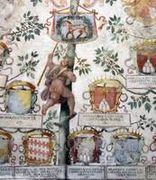Genealogy and Heraldry in the context of Federico Cesi "Linceo" (1585–1630): an example of the reception of the Middle Ages around 1600
Dr. Andreas Rehberg
Inspired by his new research on heraldry in Rome (Collection of sources on the commune of Rome in the late Middle Ages and the Renaissance), Andreas Rehberg has established an interdisciplinary group of history, art history, botany, heraldry and epigraphy exponents. In addition to the framework project, this project examines the genealogical-heraldic activity, on various levels, in the context of Accademia dei Lincei's founder Federico Cesi (1585–1630). Federico, also named "Linceo" after his lynx emblem, came from a family of Umbrian descent, who sought, over several generations, to illustrate the connection between the Roman upper classes and their art missions through iconography and heraldry. In doing so, the Cesi family not only referred to ancient mythical ancestors, but also to medieval protagonists, giving their self-representation an exemplary role in the revaluation of the Middle Ages, which can be observed in Rome, in around 1600, and whose research forms an important aspect of the project. The Cesi project is supported by Accademia dei Lincei and by the Bibliotheca Hertziana, as far as the collection of the extensive photographic documentation is concerned, even in hard-to-reach places.
Dr. Andreas Rehberg
Researcher, Responsible for Late Middle Ages and the Institute's Archive, Editor of the series "Ricerche dell'Istituto Storico Germanico di Roma"
Biography
Publications
+39 06 66049229
rehberg[at]dhi-roma.it
Publications
Heraldic Self-Representation in Roman and Latial Residences (1500–1630), in: Torsten Hiltmann/Miguel Metelo des Seixas (Eds.), Heraldry in Medieval and Early Modern State-Rooms, Ostfildern 2020 (Heraldic Studies 3), pp. 120–145.
Papes et concessions héraldiques. Exemples vaticans pour les pontificats de Sixte IV, Jules II et Léon X, in: Yvan Loskoutoff (Ed.), Héraldique et papauté. Moyen Âge-Temps modernes, Mont-Saint-Aignan 2020, pp. 147–178.
Genealogy and Heraldry as Means of Noble Self-Affirmation in Italy: the Case of the Cesi (c. 1477–1630), in: J. Eickmeyer/M. Friedrich/V. Bauer (Eds.), Genealogical Knowledge in the Making. Tools, Practices, and Evidence in Early Modern Europe, Berlin-Boston 2019 (Cultures and Practices of Knowledge in History / Wissenskulturen und ihre Praktiken 1), pp. 221–254.
Networks araldici a Roma. Il ciclo degli stemmi della Casa del Burcardo, in: Andreas Gottsmann/Pierantonio Piatti/Andreas E. Rehberg (Eds.), Incorrupta monumenta Ecclesiam defendunt. Studi offerti a mons. Sergio Pagano, prefetto dell'Archivio Segreto Vaticano, 4 vols., Città del Vaticano 2018 (Collectanea Archivi Vaticani 106–109), vol. I,2, pp. 1349–1385.
Aspetti araldici delle sepolture femminili romane del Rinascimento, in: Anna Cavallaro/Anna Esposito/Andreas Rehberg (Eds.), Donne di Pietra. Immagini, vicende, protagoniste delle sepolture romane del Rinascimento: una ricerca in corso, in: Mélanges de l'École Française de Rome. Moyen-Âge 127,1 (2015), URL: https://mefrm.revues.org/2595.


